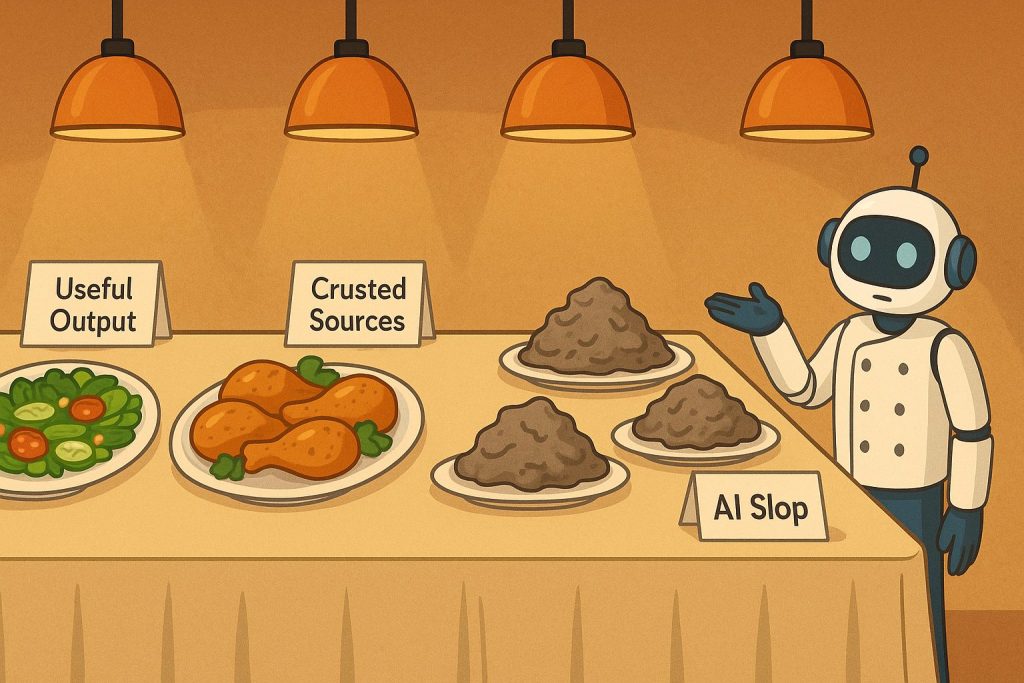
You’ve probably heard the phrase “AI slop” a fair bit lately. It’s the catch-all term for the flood of low-grade — and even lower-effort — AI-generated content that’s increasingly clogging up the internet. The name has stuck because it’s exactly right: slop is the stuff that has been mass-produced for our consumption: it’s bland, and largely devoid of real value.
AI slop is the digital equivalent of trans fats. It’s cheap to make, engineered to (just about) satisfy you, but offers no actual nourishment. You can binge it, but you won’t feel any better afterwards.
I’m not here to argue that everything humans create requires the finest ingredients, or that it needs to be assembled by artisans: there’s nothing wrong with cheap and simple. My problem is with things that are worthless yet complicated. For example: my favourite lunch in the world is a classic ham baguette*. Compare that to “formed ham”, pressed into animal shapes (treat yourself to a Google of ‘Billy Bear Ham’ if this is a new concept for you) then glued to week-old sliced bread using non-dairy ‘spread’. One is delicious and requires just three ingredients (four, if you pop in a couple of cornichons for me, thanks). It can be created in moments by any untrained passer-by, who only needs to tear open the crusty bread with their thumbs. The other requires entire production lines, product development and safety protocols to fully remove any trace of taste or joy before reaching your plate. And that’s the problem: it’s when you over-process something just to make it look like it’s more than it is that you end up with filler, waste, and a slightly queasy feeling. But all that complexity is mostly hidden from your line of sight, so you don’t have to think about the enormous cost of it all.
But you really should think about the impact of trans fats on your body, and the impact of AI slop on your capacity for critical thinking.
Helping you sound clever: Where the term came from
The word slop has long meant animal feed or cheap leftovers – a perfect, short and brilliantly descriptive middle-English word inevitably first used to refer to a puddle of animal dung. In AI, it first emerged around 2022 on forums then, in 2024, developer Simon Willison gave the term wider currency, describing “AI slop” as unreviewed, low-value content spewing out into the digital world.
By mid-2024, media outlets were warning of a “zombie internet” dominated by slop. In June 2025, John Oliver devoted a delicious Last Week Tonight rant to the phenomenon — which you should really treat yourself to watching (later, when there are no kids or sensitive relatives nearby).
Proof it’s a problem
Slop isn’t just irritating; it’s wasting resources and shaping publishing, politics, and public trust.
There are so many examples we could cite. Popular publications like Elle and Marie Claire were caught out in Belgium when they published hundreds of online articles written by fabricated AI personas with names like “Sophie Vermeulen” and “Marta Peeters.” It was cheap filler content dressed up as journalism.
That’s pretty annoying – especially for any journalists trying to get paid for the real content they created — but the slop industry gets a whole lot more dangerous when it’s weaponised. In Poland, France and elsewhere, far-right groups have pushed AI-generated visuals designed to stir up anti-immigrant feeling — from fake border clashes to surreal classroom scenes — exploiting the fact that shocking images travel faster than fact-checking. The pro-Russia Operation Overload likewise flooded Europe with AI-generated memes, articles and images. In less than a year, its output more than doubled with the help of gen AI. Here in the UK, AI-generated audio of Keir Starmer apparently swearing at staff circulated rapidly online as a fabricated “hot mic” moment running wild across X and TikTok before fact-checkers caught it. The problem is: Slop spreads fast, grabs attention, and undermines trust — and once it’s out there, corrections never get the same traction.
The inevitable sustainability angle
Slop is wasteful. Every AI-generated blob consumes compute power, electricity, and water for the data centres that require massive cooling. If the result is pointless content, that’s entirely wasted energy.
It’s like burning fuel to produce novelty ‘ham’. Processing for the sake of it doesn’t make things better; it just adds cost and environmental impact.
That’s why right-sizing AI matters.
But, let’s be clear, sometimes, the “instant noodles” version of AI is what you need — fast, cheap, and good enough. I don’t mean Pot Noodles, I mean the good stuff from the Asian supermarket, served with an egg and a few extra vegetables (aka ‘done the proper way’).
What slop overload means for you and yours
If you’re running a business or a public sector organisation, slop isn’t just an internet curiosity — it’s a warning.
Generative AI makes it easy to churn out documents, reports, or guidance at speed. But if those outputs are shallow, inconsistent, or wrong, you’re not saving time. You’re adding noise, risking reputational damage, and drowning your teams in filler. You’ll just end up re-checking and re-writing later when you realise it doesn’t really represent you.
That’s why we’ve focused on AI built to add value by default. Instead of generating from whatever it finds online, our tools are trained on curated, trusted sources — your policies, your procedures, your approved knowledge. The result: reliable, relevant content. Not slop.
It’s the difference between eating a meal that nourishes you and one that just fills you up with empty calories. Billy Bear looks kinda like ham because it’s packaged like ham and sold alongside the ham, but it’s not really ham. AI slop is the same: non-content packaged as content.
We’ve known for years that trans fats and filler foods are addictive. They light up your brain in the moment, but over time they dull your health and shorten your lifespan. We think the same is true of AI slop: scroll through thousands of pointless or inaccurate memes and clips each day, and the effect is just as real: shortened attention spans, distraction, and less capacity to focus on what matters.
The answer isn’t to swear off AI altogether, any more than it’s to stop eating anything you didn’t grow yourself. You can still eat instant noodles or enjoy the inexplicable online phenomenon of Shrimp Jesus. But do it consciously and in moderation: pay attention to what you consume — and what you serve others. Choose AI that adds value, not filler. Choose substance.
*I’m gluten intolerant. Which is super annoying. But it’s not as bad as having an actual allergy and it’s why, now and then, in France, I have a baguette jambon-beurre anyway. Then I have a three-day stomach ache. The baguette is worth it. A Billy Bear sandwich is not.



